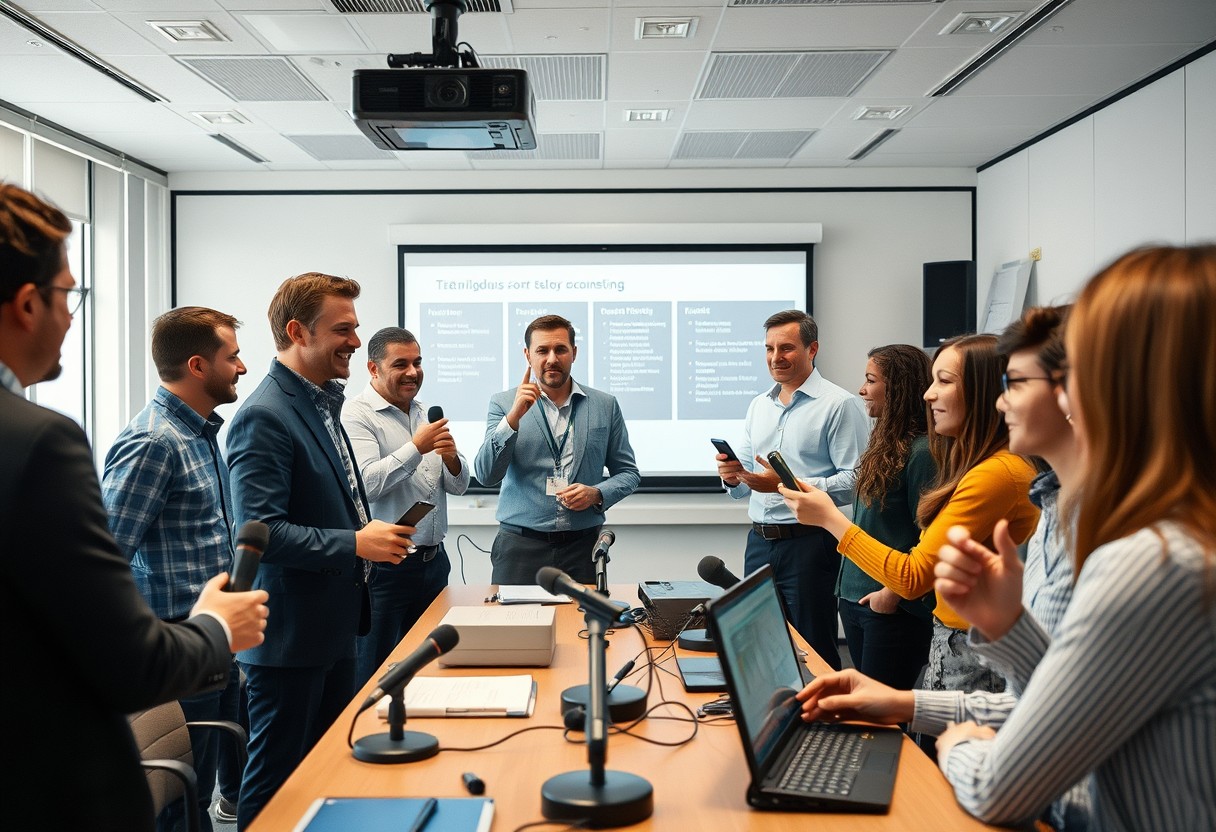
How Can Product Support Enhance The Consumer Experience In Home Appliances?
August 30, 2024
How Does Parts Ordering And Fulfillment Streamline Appliance Repair Processes?
September 3, 2024There’s no denying that effective sales training is crucial for anyone looking to excel in the competitive field of audio visual equipment. By enhancing your understanding of both the technical aspects and the latest trends in AV technology, sales training empowers you to engage customers confidently and cater to their specific needs. This mastery not only boosts your sales performance but also builds trust with your clients, ensuring long-term success in your career. Discover how investing in proper training can transform your approach to AV sales and elevate your expertise.
Key Takeaways:
- Enhanced Product Knowledge: Sales training equips individuals with a deep understanding of audio visual equipment, enabling them to confidently discuss features, benefits, and technical specifications with customers.
- Improved Sales Skills: Effective training programs focus not only on product knowledge but also on imperative sales techniques, helping sales representatives engage clients more effectively and convert leads into sales.
- Building Trust with Customers: Comprehensive training not only instills confidence in sales professionals but also fosters trust between them and clients, as customers are more likely to buy from knowledgeable representatives who can address their needs and concerns.
Understanding Audio Visual Equipment
Audio visual equipment refers to any technology used to create, transmit, or display audio and visual content. Mastering this equipment is crucial, especially in professional environments where presentations, conferences, and events are commonplace. Understanding the various types of audio visual equipment can significantly enhance your skills and effectiveness in using these tools.
Types of Audio Visual Equipment
Audio visual equipment can be categorized into several types, each serving its unique purpose. Below is a table that outlines some common types of equipment:
| Display Equipment | Monitors, projectors, and screens that display visual content. |
| Audio Equipment | Microphones, speakers, and amplifiers used for sound production and amplification. |
| Recording Devices | Cameras and audio recorders capturing audio and visual content. |
| Video Conferencing Tools | Systems enabling live communication between remote users. |
| Control Systems | Software or hardware that manage the audio visual environment. |
Thou may find it beneficial to familiarize yourself with each type, as the functionality and application can vary widely. Each piece of equipment plays a vital role in the overall effectiveness of audio visual presentations.
Importance of Audio Visual Technology
Audio visual technology plays an integral part in how your messages are conveyed and received. With the advancement of technology, it has become crucial to employ high-quality audio and visual elements to ensure a greater impact on your audience. You engage your viewers more effectively when you utilize engaging audio and visual materials, which can lead to enhanced understanding and retention of information.
Your ability to leverage this technology not only reflects on your professionalism but also on the success of your communication efforts. Maintaining an understanding of the latest technology and best practices provides you with a competitive edge in a world where effective presentation techniques are becoming increasingly important.
Understanding audio visual technology allows you to adapt your approach based on audience needs and venue requirements. Exploring these technological advancements will significantly improve your presentations and communication tactics.
Common Use Cases
The applications of audio visual equipment are vast, ranging from business presentations to entertainment settings. In professional settings, you might find equipment used for training sessions, conferences, and webinars. Even in educational environments, audio visual tools enhance learning by providing engaging and interactive content delivery.
For instance, consider a corporate meeting where you present a project using a projector and a high-quality sound system. If you’re equipped with the knowledge to operate these tools proficiently, you ensure that your audience is fully engaged and can effectively absorb the information you share. Knowing the common use cases for audio visual technology puts you in a position to wield it effectively, enhancing both your personal and professional reputation.
The Importance of Sales Training
While mastering audio visual equipment knowledge is crucial for your success in the industry, it’s equally important to recognize the imperative role that sales training plays in that journey. Effective sales training not only enhances your understanding of the equipment but also equips you with the skills to present it to potential clients convincingly. With the rapid evolution of technology, staying updated with the latest gear and software is vital, but if you are unable to communicate that knowledge effectively to your clients, you may struggle in your sales career.
Defining Sales Training
With a comprehensive definition, sales training can be described as a structured approach designed to enhance the skills, knowledge, and effectiveness of sales professionals in various industries. This training typically encompasses both product knowledge—such as specific details about audio visual equipment—and soft skills, including communication, negotiation, and persuasion techniques. Understanding these elements allows you to engage potential customers more effectively, leading to higher conversion rates and increased sales.
Objectives of Effective Sales Training
The main objectives of effective sales training are to equip you with the necessary skills, enhance your confidence, and ultimately increase your sales performance. By focusing on key areas such as product features, benefits, and customer needs, sales training provides you with a solid foundation that fosters your ability to handle objections, close deals, and build lasting relationships with clients. Achieving these objectives is crucial, as they translate directly into your professional success and the growth of your organization.
Training facilitates continuous learning and adjustment according to market trends, enabling you to respond dynamically to the ongoing changes in the audio visual equipment landscape. Furthermore, effective sales training often integrates role-playing and real-world scenarios, allowing you to practice your skills in a safe environment before applying them in actual sales situations.
The Role of Expertise in Sales
Sales in the audio visual industry demand a high level of expertise to navigate complex product offerings and understand client requirements thoroughly. By developing your expertise through sales training, you become a trusted adviser to your customers, which is invaluable. In this context, expertise doesn’t just refer to your technical knowledge about audio visual equipment; it also encompasses your ability to demonstrate that knowledge effectively to prospective buyers.
Sales expertise enables you to differentiate yourself from the competition, ultimately positioning you as a credible source of information and support. This trustworthy reputation directly correlates to your sales success, as clients are more likely to engage and purchase from someone who demonstrates a comprehensive understanding of both the product and their specific needs.

Sales Training Curriculum for Audio Visual Knowledge
Not every sales professional enters the industry with an inherent understanding of audio visual equipment. To effectively sell such products, it’s necessary for you to undergo a comprehensive sales training curriculum. This curriculum isn’t just a routine checklist but a carefully designed program that equips you with the necessary tools and understanding to excel in the audio visual sales arena.
Core Components of Sales Training
Core components of your sales training will typically include foundational topics such as product knowledge, technical understanding, and soft skills development. These elements form the bedrock of your training, ensuring you are not only familiar with the products you are selling but also able to communicate effectively with potential clients. The interaction between these components enhances your overall sales performance by providing you with a holistic view of the audio visual landscape.
Product Knowledge
One crucial aspect of your sales training is developing a strong grasp of product knowledge. This means understanding the specifications, features, and benefits of the various audio visual equipment you will be selling. Knowledge about projectors, sound systems, and video conferencing tools allows you to articulate precisely how these products can meet the specific needs of your customers.
Audio visual equipment is not just about flashy gadgets; it involves technology that can enhance communication, engagement, and overall experience in various settings. As a sales professional, you need to be aware of the market trends and how your products stand out against competitors. With a robust understanding of your offerings, you’ll be in a better position to tailor solutions that resonate with your clients, ultimately boosting your sales conversion rates.
Technical Understanding
Curriculum focusing on technical understanding of audio visual equipment is necessary for any sales professional. This involves grasping how the equipment works, the installation process, and the user experience. While your customers may appeal to you for solutions, you must possess the technical insight to guide them correctly. Technical knowledge allows you to troubleshoot issues, offer advice on best practices, and even contribute to discussions on the latest innovations within the industry, elevating your credibility in the eyes of your clients.
Understanding the technical aspects of audio visual systems builds confidence both for you and your customers. When you can articulate why a certain model is better suited for a particular environment—based on your technical understanding—you not only sell a product but also establish yourself as a trusted advisor in their decision-making process.
Soft Skills Development
Curriculum centered around soft skills development is just as critical as technical training in mastering audio visual equipment knowledge. These skills include effective communication, active listening, negotiation, and emotional intelligence. By developing these competencies, you can better facilitate interactions with potential clients, address their concerns, and close deals more effectively.
Training in soft skills equips you to navigate various customer personalities, ensuring that you can adapt your sales approach to align with their preferences and communication styles. Establishing rapport and trust is crucial in sales, particularly in the audio visual niche where emotional and experiential factors often guide purchasing decisions. The ability to relate to your clients on a personal level while exhibiting professional expertise will yield long-lasting relationships and repeat business.
Methods of Sales Training Delivery
Now, as you probe into the intricacies of mastering audio-visual (AV) equipment knowledge, understanding various sales training delivery methods is crucial. Each method offers unique advantages tailored to your learning style and sales environment. By effectively engaging with these approaches, you can significantly enhance your ability to sell AV products and solutions.
In-Person Workshops
With in-person workshops, you have the opportunity to engage directly with industry experts and fellow participants. This dynamic setting fosters an interactive learning environment where you can ask questions, share experiences, and build valuable relationships. Experiencing real-time demonstrations allows you to gain hands-on exposure to AV equipment, helping to solidify your understanding of its features and complexities.
The practical learning aspects of these workshops ensure that you not only gain theoretical knowledge but also hone your communication skills and ability to respond to customer inquiries effectively. Additionally, networking with other professionals in the field can help you discover new strategies and insights to propel your sales career forward.
Online Training Modules
Training through online training modules offers a flexible learning experience that allows you to progress at your own pace. These courses typically cover a wide range of topics relevant to AV equipment sales, such as product specifications, industry trends, and effective sales techniques. You can revisit lessons as needed, ensuring that you fully comprehend the material before moving on to more complex concepts.
In modern sales training, online modules provide access to a wealth of resources, including videos, quizzes, and interactive content. This method is particularly advantageous for individuals who may be working remotely or have scheduling constraints, giving you the freedom to balance your professional development with personal commitments.
Hands-On Demonstrations
One of the most effective methods in mastering audio-visual equipment sales is through hands-on demonstrations. This approach allows you to interact directly with the equipment, understanding its functionality and features in a practical setting. By engaging with the AV tools themselves, you can easily grasp how to present and articulate their advantages to potential clients.
To ensure you are equipped to handle various customer scenarios, hands-on demonstrations typically cover a range of equipment types and brands. This comprehensive exposure gives you the confidence to address customer questions knowledgeably and convincingly. Furthermore, the physical interaction with the equipment reinforces your learning, allowing you to remember key features and applications when it comes time to engage your own customers.
Role-Playing Scenarios
To enhance your selling skills, incorporating role-playing scenarios into your training regimen can be immensely beneficial. This method provides a simulated selling environment where you can practice your sales pitches and develop strategies for overcoming objections. By stepping into the shoes of both the salesperson and the customer, you gain insights into both perspectives, strengthening your overall sales technique.
Engaging in role-playing scenarios allows you to receive immediate feedback from peers and trainers, highlighting areas for improvement and boosting your confidence in real-life selling situations. A well-structured role-playing session can encompass various customer personas and AV equipment issues, enabling you to fine-tune your approach and adapt swiftly to client needs.

Assessing the Effectiveness of Sales Training
Unlike traditional forms of training that might focus solely on theoretical knowledge, assessing the effectiveness of sales training in mastering audio visual equipment involves measurable criteria and practical evaluations. This ensures that sales professionals can not only recall the details of the products they are selling but also translate that knowledge into real-world sales success. The right evaluation methods allow you to identify areas where your team excels as well as where further improvement is needed.
Key Performance Indicators
Assessing the effectiveness of your sales training begins with establishing Key Performance Indicators (KPIs) that align with your sales objectives. These KPIs can include metrics such as sales conversion rates, average deal size, customer engagement scores, and the duration of customer interactions. By monitoring these indicators before and after the training sessions, you can gauge the tangible impact of the training on your team’s performance, and track improvements over time.
Another effective approach is to measure product knowledge retention through assessments or quizzes. When you compare the scores of your team before and after the training, you can easily see how effectively they’ve absorbed the knowledge necessary to sell audio visual equipment. This quantitative data not only reflects your training’s effectiveness but also underscores the overall growth of your sales team.
Feedback Mechanisms
Assessing the effectiveness of your sales training also requires implementing feedback mechanisms that foster continuous dialogue between trainers and trainees. Gathering input from your sales team about the training’s relevance and real-life applicability can provide you with actionable insights. Surveys, one-on-one meetings, and team debriefs can serve as valuable tools for collecting feedback and ensuring that the training material resonates well with your team.
Furthermore, by actively encouraging your team members to express their thoughts on how the training could improve, you create an environment where development is ongoing. This two-way communication ensures that the training is not only effective in the short term but also adaptable to evolving customer needs.
For instance, you might discover that certain audio visual products require more in-depth training to clarify complex features, allowing you to adjust the training curriculum accordingly. This responsive approach to feedback enhances the relevance and effectiveness of your ongoing training programs.
Continuous Improvement
An crucial part of assessing sales training effectiveness is embracing the principle of continuous improvement. The landscape of audio visual technology is constantly evolving, which means that the training you provide to your team must also adapt to these changes. Regularly revisiting your training programs ensures that your sales team stays well-informed about the latest innovations and trends in the industry.
Incorporating a cycle of regular assessments, updates, and enhancements to your training materials means that you are committed to not only maintaining but also improving the competency of your sales team. This proactive stance allows you to identify gaps in knowledge before they impact your sales performance.
Improvement initiatives can include refresher courses, workshops on new technologies, or even guest speakers from within the industry. By prioritizing continuous improvement, you not only bolster your team’s confidence and product understanding but also enhance your overall sales performance in the highly competitive audio visual market.
Overcoming Common Challenges in Sales Training
For many organizations, implementing effective sales training can often feel overwhelming due to various inherent challenges. Addressing these challenges is critical in ensuring that your team not only gains knowledge about audio-visual equipment but also excels in selling it. This segment will explore common obstacles that sales training programs encounter and present strategies for overcoming them.
Diverse Learning Paces
Paces of learning can significantly vary among team members, making it a challenging aspect of sales training. Some individuals may grasp the intricacies of audio-visual equipment swiftly, while others may require more time to understand basic concepts thoroughly. This diversity in learning speeds can result in disparities in knowledge and confidence levels, ultimately impacting overall sales performance.
To overcome this hurdle, it’s necessary to implement personalized training methods that accommodate different learning styles. Tailored approaches, such as offering supplementary resources for those who need extra help, can help ensure that everyone is on the same page. Regular assessments can also identify who may require additional training, helping your team to build a solid foundation in audio-visual knowledge collectively.
Keeping Up with Rapid Technological Changes
Rapid advancements in technology pose another challenge for sales training in the audio-visual industry. With new products and features being introduced continuously, it can be difficult for your sales team to remain updated. Failing to keep pace with these changes can lead to misrepresentations during sales pitches and missed opportunities for building customer relationships.
To address this issue, you should establish ongoing education programs that emphasize current trends and technological innovations in audio-visual equipment. Regular workshops, webinars, and demos can immerse your team in the latest developments, ensuring they feel confident in discussing new products with customers.
With the fast-paced nature of the audio-visual industry, it’s vital to create a culture of continuous learning within your sales team. Encourage collaboration and open communication among team members so that they can share insights and experiences regarding new technologies. By fostering a collaborative environment, you’ll equip your team with the necessary skills to adapt to new changes and improve their sales effectiveness.
Engagement Strategies
Changes in training formats can also pose challenges to engaging your sales team. Traditional methods, such as one-time lectures, may not resonate well with all individuals, leading to disengagement and a lack of retention of important information regarding audio-visual equipment. As a result, salespeople may struggle to apply their knowledge in real-world scenarios.
To counteract this issue, consider innovative engagement strategies that promote interaction and skill application. Techniques such as role-playing, simulations, and hands-on experiences allow your team to practice what they’ve learned in a dynamic environment. Integrating technology, such as interactive modules or mobile learning applications, can also help maintain engagement and ensure training remains relevant.
For instance, incorporating gamification into your sales training can make learning more enjoyable and foster healthy competition among team members. By rewarding achievements and providing incentives for mastering audio-visual equipment knowledge, you can drive motivation and enhance overall engagement in your sales training program.
Summing up
Considering all points, sales training is vital for mastering audio visual equipment knowledge as it equips you with the necessary skills to communicate effectively about these products. Through a structured training program, you can deepen your understanding of the specific features and functionalities of various audio visual technologies, which empowers you to address customer inquiries confidently and accurately. This not only boosts your professional credibility but also enhances your ability to tailor solutions that meet the unique needs of your clients, leading to increased customer satisfaction and loyalty.
Furthermore, engaging in consistent sales training reinforces your learning by providing hands-on experiences and real-world scenarios, allowing you to apply theoretical knowledge in practical situations. By honing your technical expertise alongside your sales techniques, you become a well-rounded professional capable of bridging the gap between product knowledge and customer engagement. Ultimately, investing in your sales training transforms your capability to navigate the dynamic audio visual landscape, thereby driving better sales outcomes and establishing you as a trusted advisor in your field.
Q: Why is sales training important for mastering audio visual equipment knowledge?
A: Sales training is crucial for mastering audio visual equipment knowledge because it equips sales professionals with comprehensive product knowledge and understanding of customer needs. Sales training helps individuals learn technical specifications, functionalities, and benefits of various audio visual products, enabling them to confidently discuss these topics with customers. Additionally, effective training often includes role-playing scenarios that simulate customer interactions, reinforcing the application of technical knowledge in real-world situations. This not only enhances the sales team’s ability to communicate effectively with clients but also builds trust and credibility in the selling process.
Q: How does effective sales training impact customer satisfaction in the audio visual industry?
A: Effective sales training impacts customer satisfaction significantly in the audio visual industry by ensuring that sales professionals can provide accurate information and recommendations tailored to the customer’s specific needs. Trained sales representatives are better equipped to identify customer pain points and to propose suitable solutions, thus enhancing the overall purchasing experience. With a strong grasp of the products they are selling, these professionals can also address customer inquiries and concerns more efficiently, leading to higher levels of satisfaction and increasing the likelihood of repeat business, referrals, and long-term customer relationships.
Q: What are some key components of sales training for audio visual equipment?
A: Key components of sales training for audio visual equipment include comprehensive product knowledge, understanding the latest industry trends, and developing effective communication and persuasion skills. Training should cover the features and benefits of various audio visual technologies, such as projectors, sound systems, and control systems, as well as how to integrate these products within different environments. Additionally, trainers should focus on customer engagement techniques, such as active listening and empathy, to better understand customer needs. Practical sessions, including demonstrations and hands-on experience with the equipment, can further enhance proficiency and confidence in selling audio visual products effectively.

